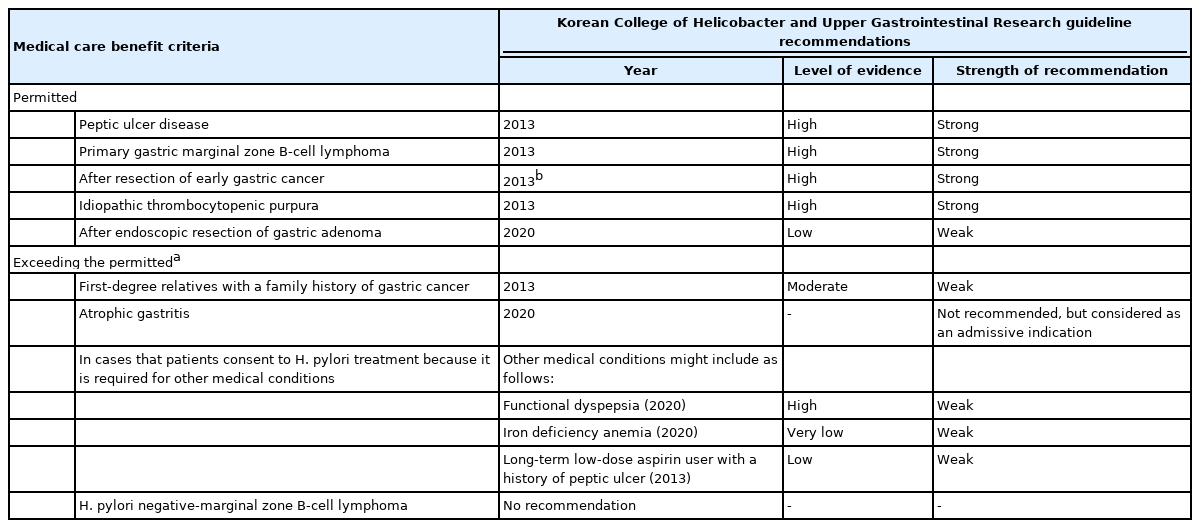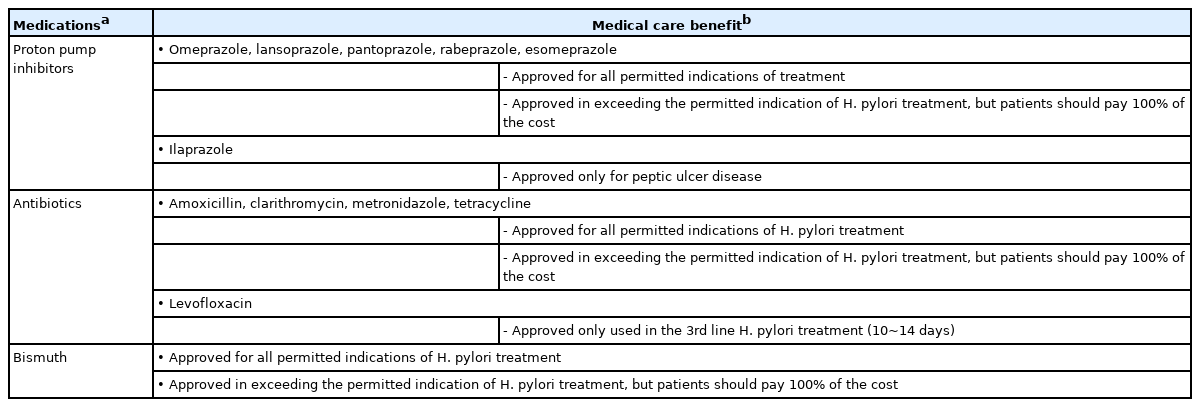헬리코박터 파일로리 제균 치료의 요양급여 인정 기준
Criteria for the National Health Insurance Service Medical Care Benefit of Helicobacter pylori Treatment
Article information
헬리코박터 파일로리(Helicobacter pylori, H. pylori)는 전세계적으로 흔한 감염균 중의 하나로, 소화성 궤양, 위암, mucosa-associated lymphoid tissue (MALT) 림프종과 같은 위장 질환을 유발하고, 철분 결핍성 빈혈, 특발성 혈소판 감소성 자반증 등의 위장관 외 질환과도 연관이 있다[1]. 2015년과 2016년 사이 조사된 우리나라의 H. pylori 유병률은 51%로 1998년 66.9%에 비하여 감소하였으나 여전히 높게 보고되었다[2]. 우리나라는 H. pylori 유병률이 높고 세계적으로 위암이 가장 많이 발생하는 나라로, 중앙암등록본부의 암 등록 통계 자료에서 위암은 2018년 29,279명(전체 발생암의 12.0%) 발생하여 가장 많이 발생한 암이었다[3]. 따라서, 위암의 원인이며, 여러 상부위장관 질환을 일으키는 H. pylori 치료에 대하여 국민건강보험 요양급여(이하 요양급여) 기준을 검토하여 보고 개선점을 제시하고자 하였다.
H. pylori 치료는 2008년 이전에는 소화성 궤양에서 요양급여가 인정되었다. 2008년부터 MALT 림프종에서의 치료가 인정되었으며, 같은 시기 조기위암 절제술은 약값 전액을 환자 부담(인정 비급여)으로 하여 H. pylori 치료를 가능케 하였다. 2018년에는 요양급여 기준이 대폭 변경되어 조기위암 절제술과 특발성 혈소판 감소성 자반증에 대한 요양급여가 추가되었고, 인정 비급여 항목으로 위선종의 내시경 절제술 후, 위암 직계 가족력, 위축성 위염 그리고 기타 제균요법이 필요하여 환자가 처방에 동의하는 경우를 포함하였다. 2019년에 H. pylori 감염 음성 MALT 림프종이 인정 비급여 항목으로 추가되었고, 가장 최근인 2022년 5월부터는 인정 비급여 항목 중의 하나인 위선종의 내시경 절제술 후가 요양급여 대상으로 변경되었다[4]. H. pylori 치료에 대한 요양급여 인정 기준은 Table 1에 정리하였다[4].

Current National Health Insurance Service Medical Care Benefit Criteria and Guideline Recommendations for the Treatment of H. pylori Infection
한편, 대한상부위장관·헬리코박터학회에서는 1998년 H. pylori 치료 적응증 정의, 감염의 진단 및 적절한 치료법에 대한 진료 지침을 제정한 후, 2009년 및 2013년 개정안을 발표하였다[5]. 이후 2020년 기존 진료 지침의 제한점을 보완하고 체계적 문헌고찰을 통하여 새로운 개정안을 발표하게 되었다[6]. H. pylori에 대한 치료의 요양급여 인정 기준은 학회의 진료 지침에서 제시하고 있는 H. pylori 치료 적응증을 대부분 수용하고 있으나(Table 1), 일부 요양급여 기준은 임상 적응증이 명확하지 않아 구체화가 필요하거나 추가적인 임상 연구의 결과에 따라 급여의 인정 범위의 변경이 필요하다.
우리나라 진료 지침에서 높은 근거 수준을 바탕으로 H. pylori 치료를 강하게 권고하는 적응증은 소화성 궤양, MALT 림프종, 조기위암의 내시경 절제 후, 특발성 혈소판 감소성 자반증으로 모두 요양급여가 인정된다. 다만, 요양급여 기준의 “조기위암 절제술”은 내시경과 외과 절제술을 구분하지 않았다. 내시경 절제술 후 H. pylori 치료의 위암 예방 효과는 확인되었으나[7], 외과 절제술 후 H. pylori 치료의 효과에 대한 연구는 드물어 제균 치료에 따른 위암 예방에 대한 근거는 부족한 실정이다. 위암 부분절제술 후에 잔류 위 점막에서 위암 발생 위험이 높을 것으로 추정되지만 이러한 연구는 진행하기 어려우므로 위암 부분절제술 후에도 H. pylori 제균 치료가 필요할 것으로 생각된다.
2020년 진료 지침 개정안에서 5편(무작위 배정 연구 2편, 후향 연구 3편)의 위선종 내시경 절제술 후 H. pylori 치료 후 이시성 위암 예방 효과를 확인한 연구를 포함하여 메타분석을 시행하였다[6]. H. pylori 제균 치료는 위선종 내시경 절제술 후 이시성 위암 발생을 45% (OR, 0.55; 95% CI, 0.34~0.92) 감소시키는 것으로 확인되어, H. pylori 치료 적응증으로 추가하였다[6]. 하지만 메타분석에 포함된 연구들은 후향 연구이거나 무작위 배정 연구의 경우에도 위선종과 조기위암 환자들을 모두 포함하는 연구들로, 진료 지침에서는 근거 수준 낮음과 권고 등급 약함으로 제시하였다. 따라서, 위선종 내시경 절제술 후의 H. pylori 치료의 위암 예방 효과는 위선종 환자만을 대상으로 하는 전향적 무작위 배정 연구를 통하여 확인이 필요하나, 가장 최근인 2022년 5월 요양급여 변경고시에서 진료 지침의 메타분석 결과와 학회의 의견을 반영하여 위선종 내시경 절제술 후에 대한 H. pylori 치료가 급여 대상으로 추가되었다.
위암 환자의 가족력(부모, 형제, 자매의 위암)은 인정 비급여 대상으로, 우리나라 진료 지침에서는 H. pylori 치료에 대해 약한 권고 사항에 해당하며, 이는 위암 환자의 가족을 대상으로 한 연구 결과가 없어, 2012년 유럽의 Maastricht 지침을 참고한 권고 사항이었다[5,6]. 2020년 국립암센터에서 위암 환자의 가족을 대상으로 H. pylori 제균 치료에 따른 위암 예방 효과에 대한 이중 맹검 무작위 배정 위약-대조군 연구의 결과가 발표되었다[8]. 9.2년의 중앙 추적 관찰 기간 동안 H. pylori 치료군은 832명 중 10명(1.2%)에서, 위약군은 844명 중 23명(2.7%)에서 위암이 각각 발생하여 H. pylori 치료군에서 위암 발생 위험은 0.45 (hazard ratio, 0.55; 95% CI, 0.21~0.94)로 유의하게 감소하였다[8]. 이 연구의 결과를 바탕으로 위암 환자의 가족력의 H. pylori 치료에 대한 치료 지침과 요양급여 인정 기준이 변경될 것으로 기대된다.
위축성 위염과 장상피화생은 현행 요양급여 기준에서 인정 비급여 대상이다. 2020년 진료 지침 개정 위원회에서 시행한 일반인을 대상으로 한 연구들을 포함한 메타분석에서 H. pylori 치료는 위암 발생의 위험을 31% (risk ratio, 0.69; 95% CI, 0.48~0.98) 감소시켰으나, 하위 분석에서는 위축성 위염이나 장상피화생을 동반한 대상자에서 위암 예방 효과를 확인할 수 없었다(risk ratio, 0.85; 95% CI, 0.48~1.52) [6]. 따라서, 진료 지침에서 위축성 위염과 장상피화생을 동반한 무증상의 환자에서 위암 예방을 위한 H. pylori 치료는 권고하지 않았다[6]. 2014년 우리나라에서 국립암센터와 국제암연구소(International Agency for Research on Cancer) 주관으로 전국의 12개 대학병원이 참여하여 H. pylori 치료에 따른 위암 예방 효과를 확인하는 이중 맹검 무작위 배정 위약-대조군 연구가 시작되어, 우리나라의 만 40~65세의 건강한 일반인 12,726명 모집을 완료하고 2029년까지 추적 검사를 진행 중이다(ClinicalTrials.gov 연구 번호 NCT02112214). 향후 일반인에 대한 H. pylori 치료의 위암 예방 효과를 확인하는 연구들의 결과들이 도출되면, 위축성 위염에 대한 H. pylori 치료 요양급여 기준의 변경과 진료 지침의 적응증의 변경 가능성이 있다.
H. pylori 치료 인정 비급여 항목에는 “기타 진료상 제균요법이 필요하여 환자가 투여에 동의한 경우”가 반영되어 있다. 이 항목은 진료 지침에서 제시하는 적응증과 상관없이 진료 의사의 재량에 따라 모든 환자에게 H. pylori 치료를 가능케 하여 불필요한 H. pylori 치료의 증가를 초래할 수 있다. 적응증의 범위를 벗어난 불필요한 H. pylori 치료는 항생제 남용에 따른 내성 증가와 내성 증가에 따른 표준 치료요법의 제균율 감소, 불필요한 항생제 사용에 따른 장내 microbiome 변화와 그에 따른 연관 질환(타장기 암, 알레르기 질환, 심혈관 질환 등) 증가 가능성 그리고 제균 치료제 및 검사에 따른 불필요한 의료비 지출 증가를 초래할 수 있다. 따라서, 임상 진료 현장의 혼란을 줄이고, 불필요한 제균 치료를 방지하기 위해 “기타 진료상 제균요법이 필요하여 환자가 투여에 동의한 경우” 항목에 대해서는 진료 지침에서 제시하고 있는 추가 적응증(기능성 소화불량증, 원인 미상의 철분 결핍성 빈혈, 이전에 소화성 궤양 병력이 있는 환자에서 장기간 저용량 아스피린 사용)을 반영하여 구체화하는 것이 필요하다.
2020년 진료 지침에서는 H. pylori에 대한 1차 치료로 14일 표준 3제요법, 10일 순차 치료 또는 동시 치료, 다른 1차 치료가 어려운 경우 10~14일 비스무스 포함 4제요법을 추천하며, 표준 3제요법, 순차 치료 또는 동시 치료 후 제균이 되지 않은 경우 2차 치료로는 비스무스 포함 4제요법을 추천한다[6]. 요양급여에서 인정하는 H. pylori 치료 약제는 진료 지침에서 제시하는 H. pylori 치료 요법에 사용되는 대부분의 약제가 포함되어 있다(Table 2). 국내에서 시판되는 대부분의 proton-pump inhibitor (PPI)는 역류성 식도염이나 위염 치료로 사용되는 저용량 제품을 제외하고 H. pylori 치료로 급여가 인정된다. Potassium-competitive acid blocker (P-CAB)는 PPI보다 강한 위산 억제 효과를 보이는 약제이다. P-CAB 중의 하나인 vonoprazan을 포함한 3제요법은 90% 이상의 제균율을 보였으며, 특히, clarithromycin 내성이 있는 환자에서도 80% 이상의 제균율을 보여 2016년 일본의 H. pylori 치료 지침에서는 vonoprazan을 포함하는 3제요법을 H. pylori 1차 치료로 포함하였다[9]. 우리나라에서는 P-CAB 중 tegoprazan이 역류성 식도염과 위궤양의 치료로 허가를 받았으나, H. pylori 제균 치료로는 요양급여 기준에 포함되지 않아 현재 국내 임상 연구가 진행 중이다. 한편, 1차 또는 2차 치료로 비스무스 포함 4제요법을 사용한 후 H. pylori 제균이 실패한 경우, levofloxacin 3제요법이 추천되나, levofloxacin의 내성률이 높아 제균율은 57% 정도로 낮은 문제점이 있다[6]. 따라서, 진료 지침에서는 추가적인 대안으로 levofloxacin 4제요법, rifabutin 포함 3제요법, 고용량 2제요법 그리고 동시 치료를 같이 제시하였다[6]. 제시된 치료법 중, rifabutin을 포함한 3제요법은 rifabutin이 결핵 또는 비정형 결핵의 치료에만 요양급여가 인정되고 있어 사용이 어렵다. Rifabutin은 골수독성과 같은 부작용이 있고, 사용에 따른 결핵균의 내성 증가를 초래할 수 있으나, 1~2차 제균 치료에 실패한 H. pylori 치료로 제한하여 급여 인정을 받는다면 H. pylori 제균이 반드시 필요한 환자들에게 도움이 될 것이다.

Medications Approved for H. pylori Eradication Therapy According to the Current National Health Insurance Service Medical Care Benefits
우리나라 진료 지침에서는 H. pylori 검사 방법으로 침습적 검사법인 신속요소분해효소 검사(rapid urease test, RUT), 조직 검사와 비침습적 검사법인 요소호기 검사(urea breath test, UBT), 혈청 검사 그리고 대변항원 검사를 추천한다[5]. 이와 같은 H. pylori 검사에 대한 요양급여는 H. pylori 균주 검사와 UBT 검사로 구분하여 고시되고 있다(Table 3). H. pylori 균주 검사의 요양급여는 RUT, 조직 검사, 혈청 검사, 대변항원 검사가 인정되나, 실제 고시에서는 구체적인 검사법이 제시되지 않아 진료 현장에 혼란을 주고 있다. UBT는 별도의 요양급여 기준이 고시되고 있는데, 고시된 요양급여 기준은 H. pylori 치료 후 제균 여부를 확인하는 경우와 감염 진단 목적으로 시행할 수 있는 경우로 분리되어 있다. H. pylori 감염 진단 목적으로 사용할 수 있는 경우는 내시경으로 소화성 궤양이 확인되었으나 출혈 위험으로 조직 생검이 어려운 환자와 특발성 혈소판 감소증 환자이다(Table 3). 향후 H. pylori 검사에 대해서는 요양급여가 인정되는 검사법을 구체적으로 명시해야 한다. 또한, 최근에 H. pylori 치료가 인정된 위선종의 내시경 절제술 후를 검사에 대한 적응증으로 반영할 필요가 있다.

Current National Health Insurance Service Medical Care Benefit Criteria for the Diagnosis of H. pylori Infection
Clarithromycin 내성 검사는 최근 내성 증가에 따른 제균 치료제 선택에 도움을 주며, 중합효소 연쇄반응법(PCR)과 염기서열 분석법(next generation sequencing, NGS)이 요양급여에 포함되어 있다(Table 3). 두 가지 방법 중 한 가지 검사만이 요양급여가 인정되며, NGS 검사는 환자가 80%의 비용을 부담하는 선별 급여 대상이다. H. pylori 감염이 이미 확인된 경우에 요양급여가 인정되기 때문에, 일부에서는 2차례의 위내시경 생검(H. pylori 진단, 내성 검사 시행)이 필요할 수 있다. 따라서, 요양급여 기준을 일부 개정을 통하여 H. pylori 제균 치료가 필요한 환자에서 UBT와 같이 비침습적인 검사로 H. pylori 감염 여부를 확인 후 감염자에서 조직 검사를 통한 내성 검사 를 진행할 수 있는 방안이 도움이 될 것이다.
결론적으로 H. pylori 치료 및 검사의 요양급여 기준은 전문가 합의와 체계적 문헌고찰을 바탕으로 발표된 진료 지침을 바탕으로, 실제 임상 현장에 있는 진료 의사와 환자들의 요구를 반영하고, H. pylori 치료 효과와 급여 재정을 고려하여 합리적으로 결정 또는 개정되어야 할 것으로 사료된다.
Notes
No potential conflict of interest relevant to this article was reported.
